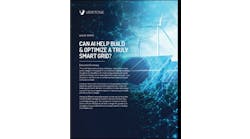Puerto Rico Energy Commission Opens Docket on Microgrids and Distributed Generation
Puerto Rico’s energy commission has opened a docket to investigate ways to encourage microgrids and distributed generation to build an energy system with more fortitude against hurricanes.
Island officials described the docket this week in testimony before the U.S. Senate Committee on Energy and Natural Resources. Half of the island’s population remains without power two months after Hurricane Maria’s strike.
José Román Morales, acting chairman of the Puerto Rico Energy Commission, said that the island is trying to simultaneously both “restore and transform” the crushed power grid.
The island needs to “adopt and implement alternatives that allow greater resilience and faster restoration. Distributed generation technologies, such as microgrids, have the potential for restoring power to unserved areas and providing stability to recently reconnected areas,” Morales said.
The idea is to use the disaster to rebuild in a way that helps avert massive outages from future storms and helps the island “respond to future emergencies more quickly and cost-effectively,” he said.
The docket also will look at ways to increase private participation in restoration efforts and reduce dependence on centralized generation. (Case No. CEPR-IN-2017-0002).
Morales and others also asked for changes in federal rules on how federal emergency disaster funds are used. As it stands now, the funds can only be used to rebuild the grid to its pre-storm conditions and not to add new microgrids.
Murkowski: Rebuild in a smarter manner
Sen. Lisa Murkowski, chairwoman of the Senate Committee on Energy and Natural Resources, said it makes little sense to recreate the former grid, pointing out its vulnerabilities.
“More hurricanes will impact the islands in the years to come. We’re going to see poles that will break, lines that will come down,” she said. “Communities will be disconnected from each other and from a central grid.”
Instead, she wants the islands to rebuild “in a smarter manner, whether through microgrids, distributed generation, burying the lines where possible, direct current versus alternate. We need to be looking at this going forward.”
Sen. Lisa Murkowski, chairwoman, Senate Committee on Energy and Natural Resources
Murkowski said she will advocate for using the federal funds to create a new, more resilient grid. Her home state, Alaska, has 12 percent of the world’s microgrids, making it the global leader for deployment of the technology.
Puerto Rico Gov. Ricardo Rosselló Nevares told the committee that the island’s “electric grid experienced a complete failure with damage to every major transmission line, thousands of towers and poles were down, and generation facilities were damaged.”
In rebuilding the grid, the island is seeking “best-in-class thinking” to explore a range of public and private infrastructure ownership options, Rosselló said.
The goal is to “aggressively incorporate advancements,” he said, “and create frameworks for distributed energy resources and virtual power plants.” Puerto Rico wants to create the “right market and competitive signals” for sustainable and reliable power delivery.
Even as it looks to strengthen its grid for the future, Puerto Rico remains mired in a struggle to get power flowing again to half of its customers.
Ricardo Ramos, executive director of the Puerto Rico Electric Power Authority (PREPA) , warned that restoring power to the remaining areas “will be vastly more difficult than our work so far.”
“The areas currently without power are more isolated and more mountainous. Restoring power to these communities requires unique skills, experience, and equipment, and it will take significantly more resources, time, and effort,” he said.
Virgin Islands’ 5th time rebuilding grid
The U.S. Virgin Islands expects to have power fully restored by year’s end. It too is thinking about how to avoid a repeat of such sweeping outages. This marks the fifth time the federal government is paying to rebuild the power distribution system in the Virgin Islands, according to USVI Gov. Kenneth Mapp.
“We’re already taking basic steps to improve the resilience of the grid as we build it back, using things like composite poles that can better withstand hurricane force winds, but we must go further. With your help, we plan to bury power lines on the primary and secondary road systems throughout the Virgin Islands and invest in microgrid systems that will add renewable generation capacity — things like solar and wind energy — to the system,” he said.
What should the next steps in Puerto Rico and the Virgin Islands. Please post your thoughts on our LinkedIn Group, Microgrid Knowledge.







